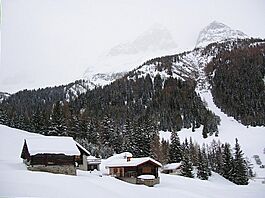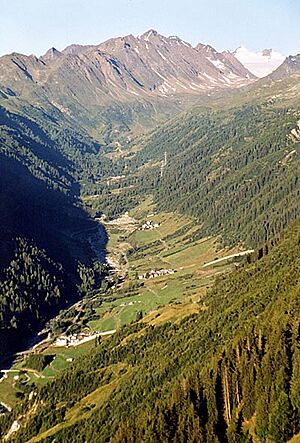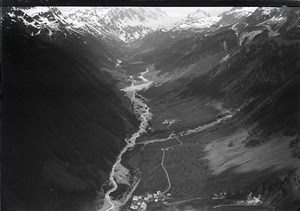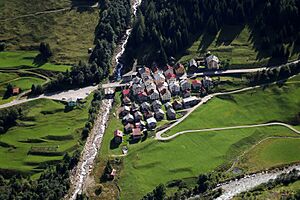Bedretto facts for kids
Quick facts for kids
Bedretto
|
||
|---|---|---|
 |
||
|
||
| Country | Switzerland | |
| Canton | Ticino | |
| District | Leventina | |
| Area | ||
| • Total | 75.18 km2 (29.03 sq mi) | |
| Elevation | 1,402 m (4,600 ft) | |
| Population
(Dec 2020 )
|
||
| • Total | 102 | |
| • Density | 1.357/km2 (3.514/sq mi) | |
| Postal code |
6781
|
|
| Surrounded by | Airolo, Cevio, Formazza (IT-VB), Lavizzara, Oberwald (VS), Realp (UR), Ulrichen (VS) | |
Bedretto (which is called Bidré in a local language called Lombard) is a small town and village in Switzerland. It's located in the Val Bedretto, which is the very top part of the Ticino river valley. Bedretto is part of the Leventina district in the Ticino canton.
Contents
A Look Back: Bedretto's History
Ancient Discoveries in Bedretto
In 1906, some really old graves from before the Roman times were found in Bedretto. People also discovered a Roman era villa (a large country house) and old Roman coins. This shows that people lived here a very long time ago!
Bedretto as a Separate Community
Bedretto was first mentioned in records in 1210. Back then, it was already its own separate town. In 1227, when the mountain pastures in the Leventina valley were divided, Bedretto had its own smaller farms and villages around it. It was the only community that didn't get any extra mountain pastures.
The Church and Its Challenges
In 1227, Bedretto was also mentioned as having its own parish (a church area). The main church, called SS Martiri Maccabei, was in the settlement of Villa. It had to be rebuilt after a big avalanche destroyed it in 1594. The church building you see today is from the 1800s.
Mountain Crossings and Avalanches
A special building called a hospice in a place called All'Acqua was a starting point for two famous mountain paths. One path, the Nufenen Pass, leads to Ulrichen in the Upper Valais. The other, the Passo di San Giacomo, goes to the Italian Formazza valley. These paths were important for travel and trade long ago.
The Bedretto Valley has very steep slopes, which means avalanches often hit the villages. In 1863, an avalanche destroyed half the village and sadly killed 29 people. Another one in 1749 killed 13 people. In winter, the valley can be completely cut off, meaning villages can't reach each other or the town of Airolo for days. Luckily, building special barriers has made the situation much safer.
Connecting the Valley
The road connecting Airolo and Bedretto was opened in 1924. It was later extended in 1932 and again in 1964. Even with these roads, the valley is still quite isolated. There was a plan for a train line to connect the valley, but it didn't happen.
Life and Migration in the Past
Historically, it was hard to make a living in the valley. There wasn't enough food from cattle, dairy farming, potatoes, and rye to feed everyone. So, many people had to leave for parts of Italy and France during certain seasons to find work. They worked as things like chestnut roasters, waitresses, or house helpers. After World War II, this seasonal migration stopped. Because of this, fewer people live in the valley permanently now. However, in the summer, many locals return, and in winter, tourists and holiday guests visit.
Exploring Bedretto's Geography
Bedretto is nestled in the Bedretto Valley. This valley stretches from the Nufenen Pass down to Airolo, following the path of the Ticino river's beginnings. The municipality includes the main village of Bedretto and smaller settlements called hamlets, like Ronco, Villa (where the local government is), and Ossasco.
The area of Bedretto is about 75.23 square kilometers (about 29 square miles). A small part, about 2%, is used for farming. A bigger part, about 11.6%, is covered by forests. Most of the land, about 55.9%, is unproductive, meaning it's too rocky or has too little plant life to be used for farming or building.
Bedretto's Coat of Arms
The coat of arms for Bedretto is quite simple and shows two larch trees. It has a green side and a silver (or white) side, and the trees are colored opposite to the background they are on.
Who Lives in Bedretto?
Bedretto has a small population. As of 2008, about 12.2% of the people living there were from other countries. Over ten years (from 1997 to 2007), the population changed by about 7.8%.
Most people in Bedretto speak Italian (about 91.7%). Some also speak German (4.2%) and French (4.2%).
In 2008, there were slightly more men (52.2%) than women (47.8%) living in Bedretto. The population has been slowly decreasing.
Population Over Time
Here's how Bedretto's population has changed over many years:
| year | population |
|---|---|
| 1567 | 38 Hearths (families) |
| 1745 | 293 |
| 1798 | 594 |
| 1850 | 388 |
| 1900 | 257 |
| 1930 | 275 |
| 1950 | 213 |
| 1960 | 148 |
| 1970 | 117 |
| 1980 | 77 |
| 1990 | 50 |
| 2000 | 72 |
What to See in Bedretto
The entire villages of Bedretto and Villa are considered important historical sites. They are part of the Inventory of Swiss Heritage Sites, which means they are protected for their special value.
Bedretto's Economy
In 2007, Bedretto had a very low unemployment rate, meaning almost everyone who wanted a job had one.
How People Work
- Primary Sector: In 2005, 5 people worked in the primary sector, which means jobs like farming or forestry.
- Secondary Sector: 10 people worked in the secondary sector, which includes jobs like manufacturing or construction.
- Tertiary Sector: 12 people worked in the tertiary sector, which covers services like tourism, shops, or offices.
Many people who live in Bedretto travel to other places for work. In 2000, 16 workers left the municipality for their jobs, while only 4 came into Bedretto to work. Most people (38.7%) used a private car to get to work, while a small number (3.2%) used public transportation.
Tourism
As of 2009, Bedretto had 3 hotels with a total of 19 rooms and 45 beds. This shows that tourism is a part of the local economy.
Religion in Bedretto
According to the 2000 census, most people in Bedretto (90.3%) were Roman Catholic. A smaller number (2.8%) belonged to the Swiss Reformed Church.
Education in Bedretto
Many adults in Bedretto (about 61.3% of those aged 25–64) have completed more than just basic schooling. This means they have either finished upper secondary education or gone on to higher education like university.
In 2009, there were 3 students in Bedretto. The local education system offers different levels of schooling:
- Kindergarten: There were no children in kindergarten in Bedretto.
- Primary School: This program lasts for five years.
- Lower Secondary School: Students can either go to a two-year middle school or a four-year program to prepare for higher education. In 2009, 1 student was in the four-year advanced program.
- Upper Secondary School: This prepares students for a trade or university. In 2009, 2 students were attending vocational school part-time.
In 2000, 7 students from Bedretto went to schools outside the municipality.
Famous People from Bedretto
- Raffaele Forni: He was a bishop and a nuncio (a diplomat for the Pope).
See also
 In Spanish: Bedretto para niños
In Spanish: Bedretto para niños







